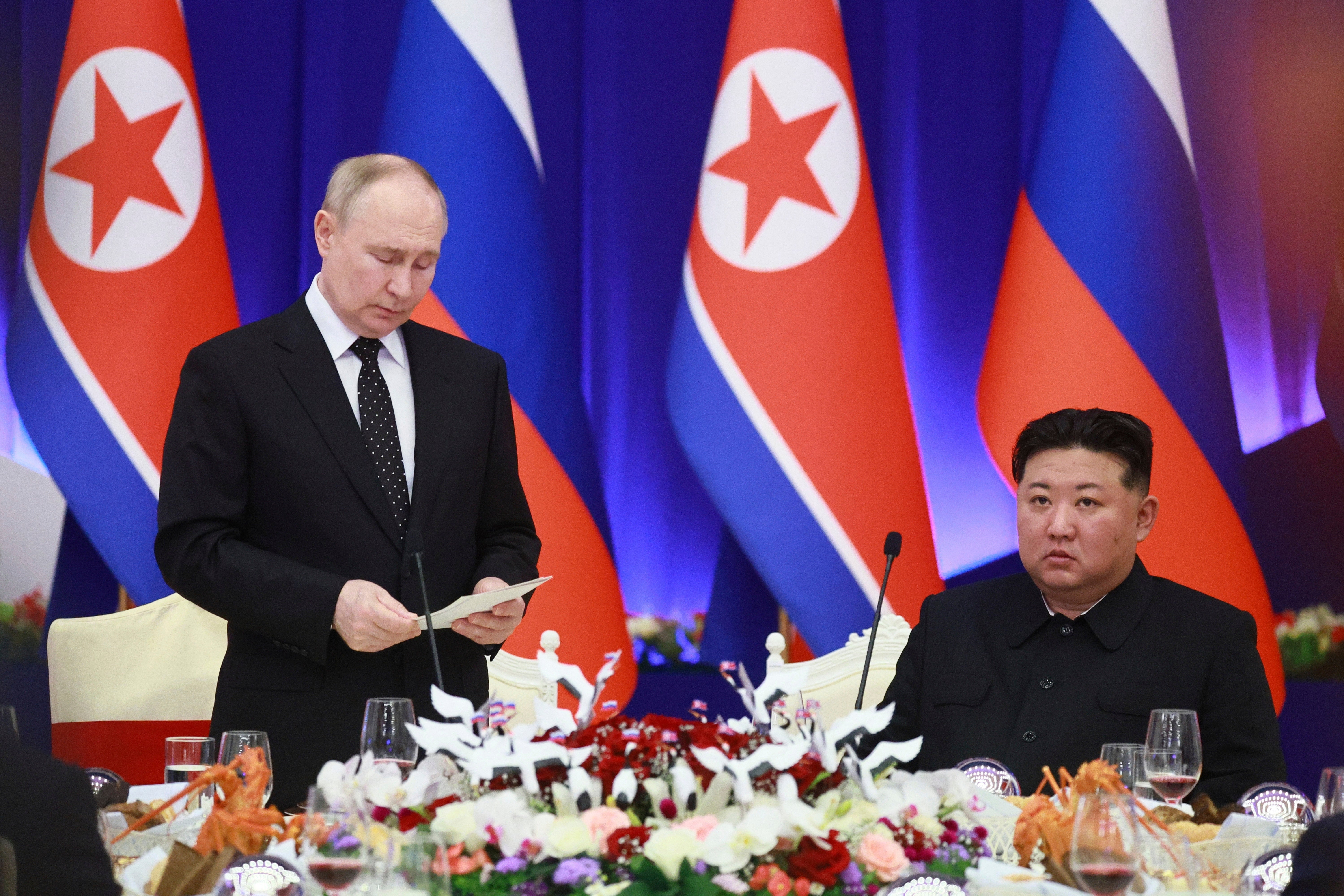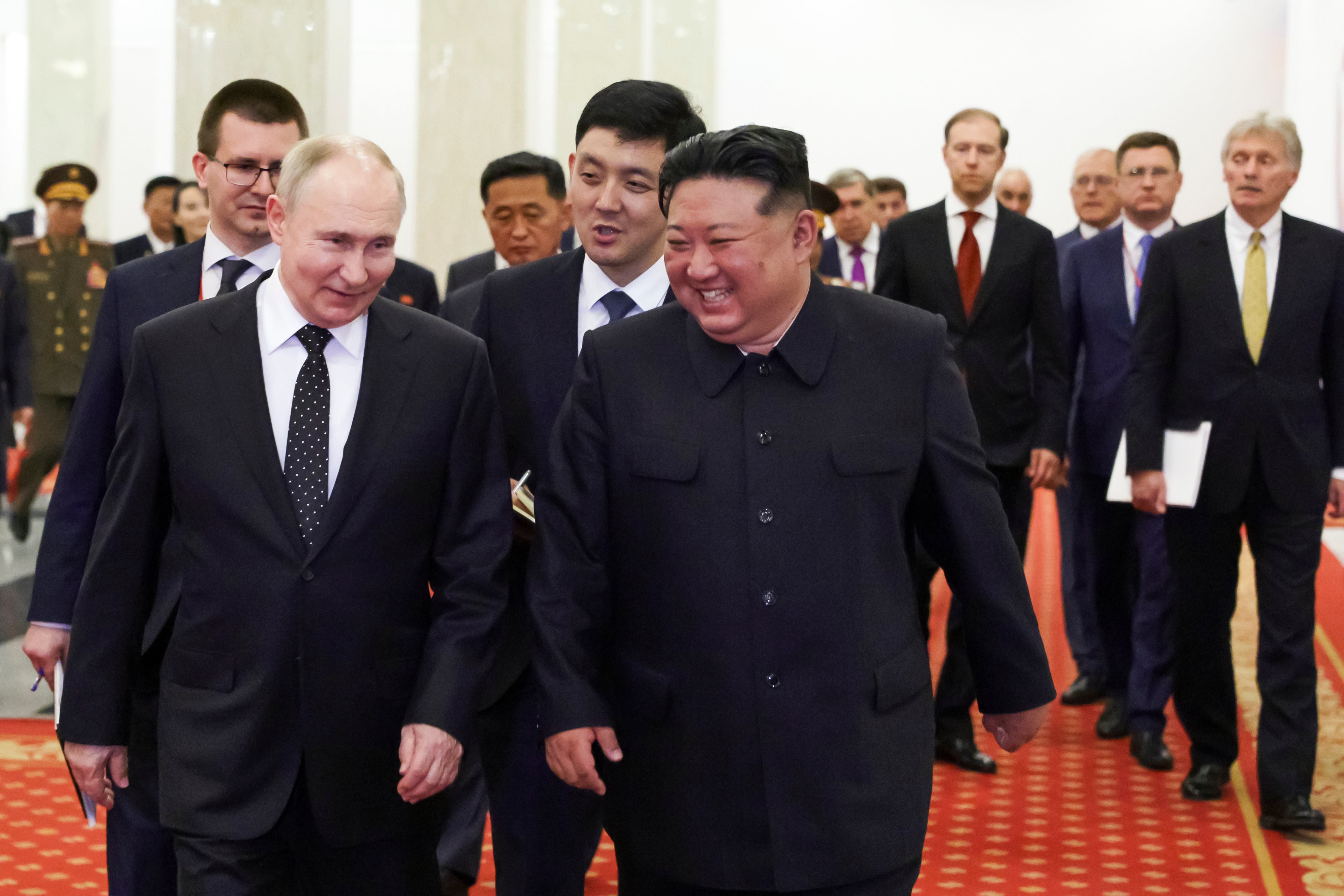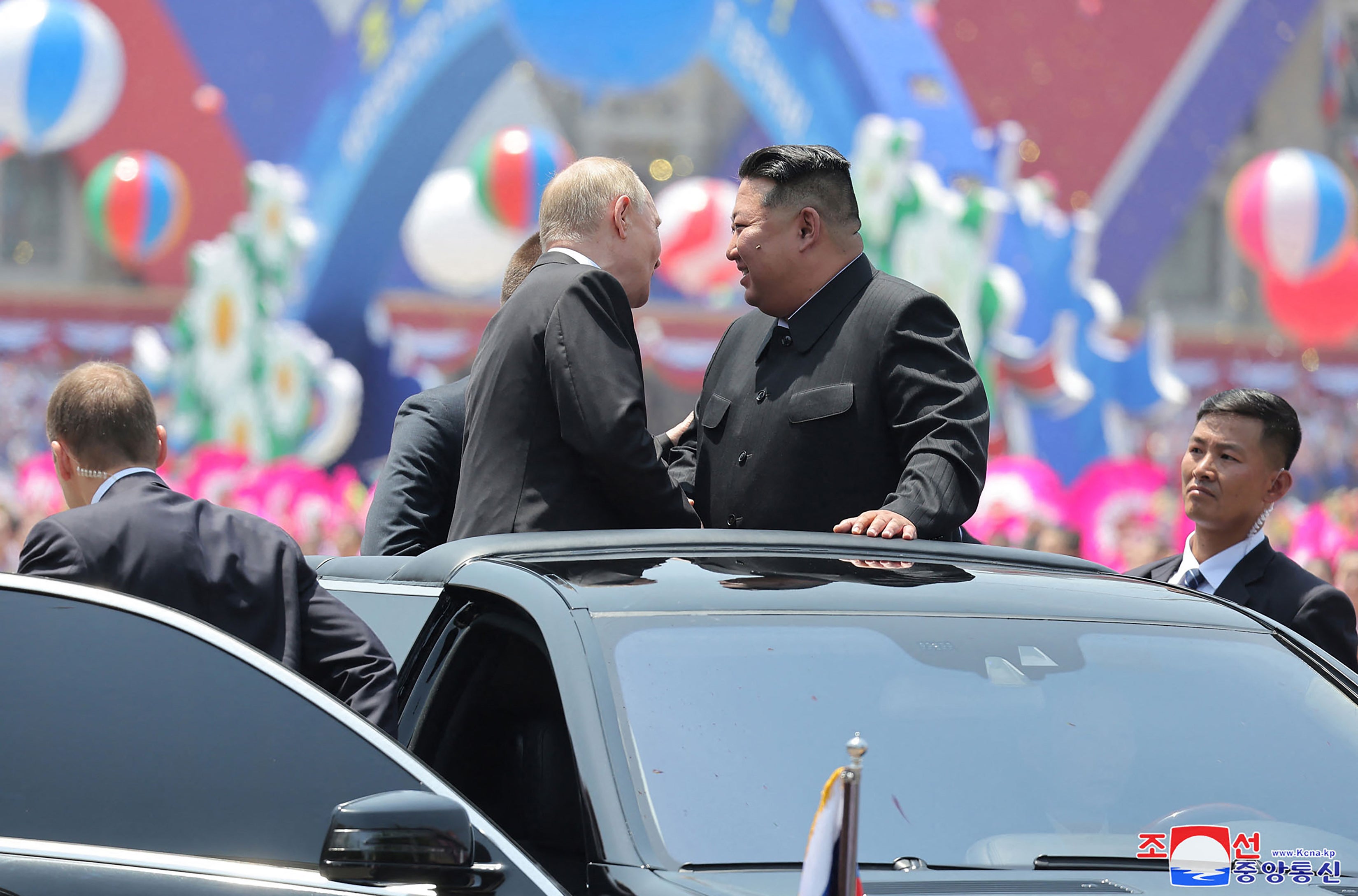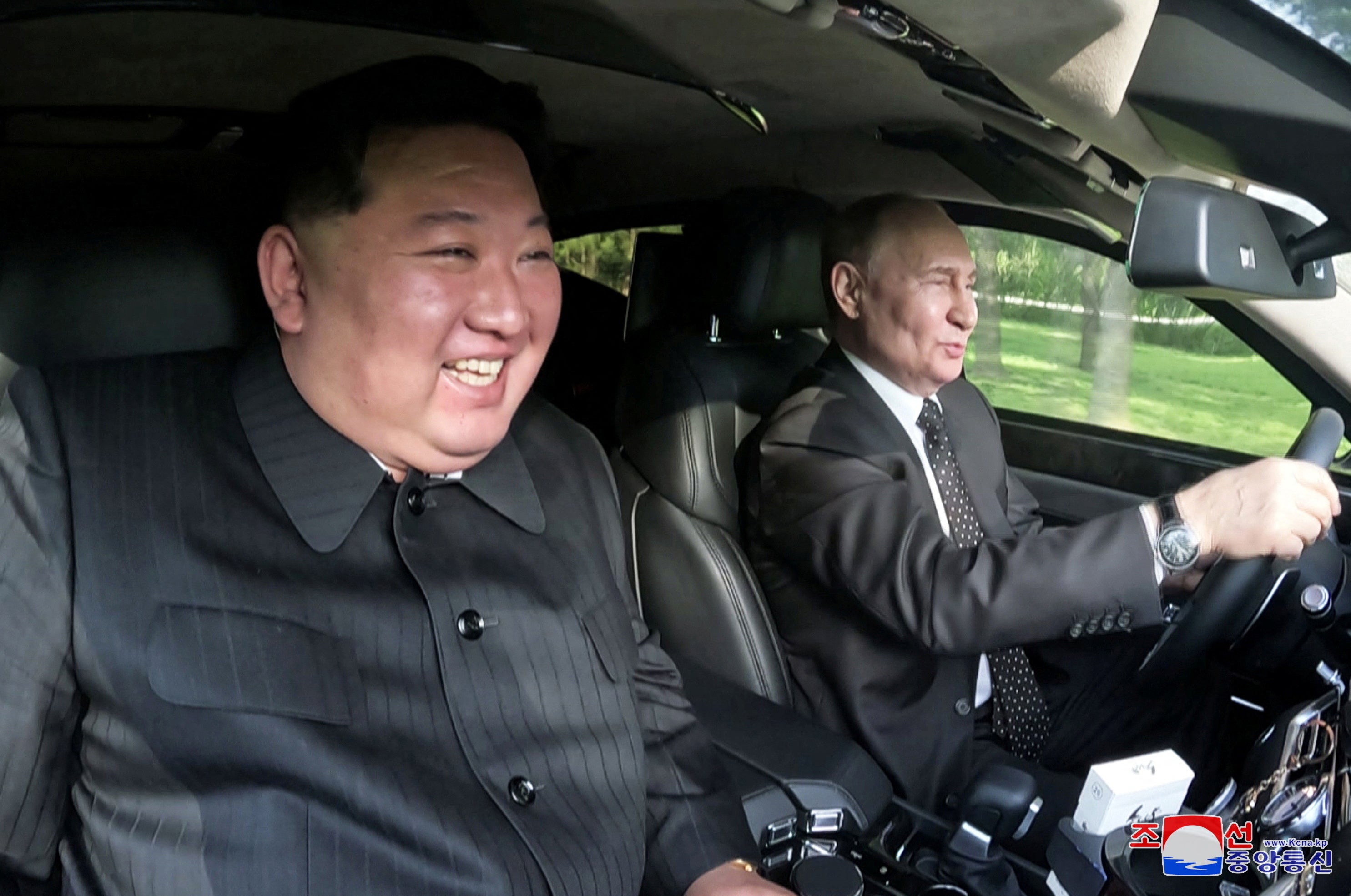
In a pool photograph distributed by the Russian state agency Sputnik, Russian President Vladimir Putin and North Korean leader Kim Jong Un toast during a reception at the Mongnangwan Reception House in Pyongyang on June 19, 2024. Putin enjoyed a red carpet welcome, a military ceremony and an embrace from North Korea’s Kim Jong Un during a state visit to Pyongyang where they both pledged to forge closer ties.
(Vladimir Smirnov/Pool/AFP) / — Editor’s note : this image is distributed by the Russian state owned agency Sputnik
By TRIBUNE NEWS SERVICE | Tribune News Service
PUBLISHED: June 20, 2024
Soo-Hyang Choi and Jon Herskovitz | (TNS) Bloomberg News
Russia and North Korea revived a deal struck during the Cold War when their leaders met in Pyongyang this week and agreed to come to each other’s defense if they are ever attacked. The deal is likely a reward for Kim Jong Un for supplying massive amounts of munitions to help Vladimir Putin in his war on Ukraine. How it will be actually implemented is still a question, but the pact sets Russia and North Korea on a path that keeps them in lockstep as they try to vex the U.S. and its partners.
1. What did the two agree to?
They agreed to immediately provide “military and other assistance” if either of them is attacked. Dubbed the Treaty on the Comprehensive Strategic Partnership, it is similar to a 1961 deal signed during the Cold War which was scrapped after the collapse of the Soviet Union. The level of assistance the two sides will provide each other is unclear. Putin and Kim also agreed to take joint measures to strengthen their defense capabilities and expand cooperation in trade and investment — all of which could be in violation of international sanctions. The treaty will be effective indefinitely until either of them seeks its expiration.
2. What’s in it for North Korea?
Kim gets an ally with a nuclear arsenal to back him up. It also means he can continue to pursue his own atomic ambitions with Russia using its veto power at the United Nations Security Council to block any new sanctions. Putin said the treaty sets the stage for boosting their cooperation in trade, investment as well as in security matters for the long term, all of which are what North Korea wants. Kim needs cash, commodities and technology to help with his plans to build a nuclear-powered submarine and deploy an array of spy satellites. North Korea’s economy was estimated by South Korea’s central bank to have been worth about $24.5 billion in 2022, and any assistance makes a big difference. Russia has so far provided North Korea with food, raw materials and parts used in weapons manufacturing, South Korean Defense Minister Shin Wonsik has said. If the arms transfers grow, Russia will likely send more military technology, increasing Pyongyang’s threat to the region, Shin said.
3. Why did Putin reach the deal?
In the near term, Putin rests assured that he can tap North Korea for weapons that allow him to keep up his grinding war on Ukraine. He has already received millions of artillery shells and scores of ballistic missiles, Shin said in an interview with Bloomberg News. The pact is a way to show defiance of the U.S. and its partners in the face of sanctions. How much Putin will commit to the actual defense of North Korea is another matter. The Soviet Union did not fully commit to fight on behalf of North Korea during the 1950-1953 Korean War, and stepping into a conflict now would almost certainly mean taking on a U.S.-led coalition.
“Russian diplomats will likely be telling other governments not to worry and that they won’t do anything stupid — that Putin is just paying Kim off with a show, with meaningless gestures,” Stephen Sestanovich, a senior fellow for Russian and Eurasian Studies at the Council on Foreign Relations said in comments posted on a CFR webpage. “What we don’t know is what’s been promised in secret — or will be promised over time,” he wrote.
4. How does this affect the U.S.?
The U.S. has to recalculate what might happen if it uses weapons against North Korea. An option discussed during the Trump administration was a “bloody nose” strike on North Korea designed to hit a key facility or two and remind Kim that his antiquated military is no match for America’s might. The deal means the U.S. has to plan for the contingency of a Russian response. The pact also makes it easier for Kim to ignore Washington’s call to return to nuclear talks, where aid is offered in exchange for him winding down his atomic arsenal. “What we’re most worried about — Russian sharing and transfer of weapons technology to North Korea and the consequential proliferation — would also be in the realm of possibilities,” said Soo Kim, a former Korea analyst at the Central Intelligence Agency who now works at U.S.-based management consulting firm LMI.
5. Does this mean North Korea will send soldiers to fight in Ukraine?
North Korea for years has supplied workers to Russia — mostly in its Far East for forestry and construction projects — in return for hard cash. But sending troops to fight against Ukraine may be a bridge too far for Kim. Instead, he could dispatch workers to parts of Ukraine occupied by Russia. Since Putin demands that his invasion be called a “special military operation” it could be difficult for him to invoke the pact, unless there is a significant attack on the Russian homeland.
___
©2024 Bloomberg L.P. Visit bloomberg.com. Distributed by Tribune Content Agency, LLC.
By TRIBUNE NEWS SERVICE | Tribune News Service
PUBLISHED: June 20, 2024
Soo-Hyang Choi and Jon Herskovitz | (TNS) Bloomberg News
Russia and North Korea revived a deal struck during the Cold War when their leaders met in Pyongyang this week and agreed to come to each other’s defense if they are ever attacked. The deal is likely a reward for Kim Jong Un for supplying massive amounts of munitions to help Vladimir Putin in his war on Ukraine. How it will be actually implemented is still a question, but the pact sets Russia and North Korea on a path that keeps them in lockstep as they try to vex the U.S. and its partners.
1. What did the two agree to?
They agreed to immediately provide “military and other assistance” if either of them is attacked. Dubbed the Treaty on the Comprehensive Strategic Partnership, it is similar to a 1961 deal signed during the Cold War which was scrapped after the collapse of the Soviet Union. The level of assistance the two sides will provide each other is unclear. Putin and Kim also agreed to take joint measures to strengthen their defense capabilities and expand cooperation in trade and investment — all of which could be in violation of international sanctions. The treaty will be effective indefinitely until either of them seeks its expiration.
2. What’s in it for North Korea?
Kim gets an ally with a nuclear arsenal to back him up. It also means he can continue to pursue his own atomic ambitions with Russia using its veto power at the United Nations Security Council to block any new sanctions. Putin said the treaty sets the stage for boosting their cooperation in trade, investment as well as in security matters for the long term, all of which are what North Korea wants. Kim needs cash, commodities and technology to help with his plans to build a nuclear-powered submarine and deploy an array of spy satellites. North Korea’s economy was estimated by South Korea’s central bank to have been worth about $24.5 billion in 2022, and any assistance makes a big difference. Russia has so far provided North Korea with food, raw materials and parts used in weapons manufacturing, South Korean Defense Minister Shin Wonsik has said. If the arms transfers grow, Russia will likely send more military technology, increasing Pyongyang’s threat to the region, Shin said.
3. Why did Putin reach the deal?
In the near term, Putin rests assured that he can tap North Korea for weapons that allow him to keep up his grinding war on Ukraine. He has already received millions of artillery shells and scores of ballistic missiles, Shin said in an interview with Bloomberg News. The pact is a way to show defiance of the U.S. and its partners in the face of sanctions. How much Putin will commit to the actual defense of North Korea is another matter. The Soviet Union did not fully commit to fight on behalf of North Korea during the 1950-1953 Korean War, and stepping into a conflict now would almost certainly mean taking on a U.S.-led coalition.
“Russian diplomats will likely be telling other governments not to worry and that they won’t do anything stupid — that Putin is just paying Kim off with a show, with meaningless gestures,” Stephen Sestanovich, a senior fellow for Russian and Eurasian Studies at the Council on Foreign Relations said in comments posted on a CFR webpage. “What we don’t know is what’s been promised in secret — or will be promised over time,” he wrote.
4. How does this affect the U.S.?
The U.S. has to recalculate what might happen if it uses weapons against North Korea. An option discussed during the Trump administration was a “bloody nose” strike on North Korea designed to hit a key facility or two and remind Kim that his antiquated military is no match for America’s might. The deal means the U.S. has to plan for the contingency of a Russian response. The pact also makes it easier for Kim to ignore Washington’s call to return to nuclear talks, where aid is offered in exchange for him winding down his atomic arsenal. “What we’re most worried about — Russian sharing and transfer of weapons technology to North Korea and the consequential proliferation — would also be in the realm of possibilities,” said Soo Kim, a former Korea analyst at the Central Intelligence Agency who now works at U.S.-based management consulting firm LMI.
5. Does this mean North Korea will send soldiers to fight in Ukraine?
North Korea for years has supplied workers to Russia — mostly in its Far East for forestry and construction projects — in return for hard cash. But sending troops to fight against Ukraine may be a bridge too far for Kim. Instead, he could dispatch workers to parts of Ukraine occupied by Russia. Since Putin demands that his invasion be called a “special military operation” it could be difficult for him to invoke the pact, unless there is a significant attack on the Russian homeland.
___
©2024 Bloomberg L.P. Visit bloomberg.com. Distributed by Tribune Content Agency, LLC.
Why the deal between North Korea and Russia falls short in bid to create ‘axis of impunity’ to rival Nato
Analysis: Experts say deal between Putin and Kim could have major military implications, despite its limitations
Analysis: Experts say deal between Putin and Kim could have major military implications, despite its limitations
THE INDEPENDENT UK
June 20,2024
Vladimir Putin’s military pact with Kim Jong-un represents a “pariah partnership” between two countries that are emerging as key components of an autocratic, anti-Western “axis of impunity”, experts say.
During his meeting with the North Korean leader on Wednesday, Putin signed a “comprehensive partnership agreement”, marking a significant breakthrough and upgrade in a relationship that had been gathering dust until Russia launched the Ukraine war.
Isolated on the international stage with Western sanctions taking a toll on the Russian economy, Putin has been casting around for ways to alleviate the pressure and feed his war machine. Western intelligence agencies say Moscow has begun importing large volumes of North Korean arms in exchange for basic food supplies and technological knowhow.
Rachel Lee, a senior fellow at the Stimson Center’s Korea programme, told The Independent that the treaty “has the potential to have major military implications in the region”.

Vladimir Putin’s military pact with Kim Jong-un represents a “pariah partnership” between two countries that are emerging as key components of an autocratic, anti-Western “axis of impunity”, experts say.
During his meeting with the North Korean leader on Wednesday, Putin signed a “comprehensive partnership agreement”, marking a significant breakthrough and upgrade in a relationship that had been gathering dust until Russia launched the Ukraine war.
Isolated on the international stage with Western sanctions taking a toll on the Russian economy, Putin has been casting around for ways to alleviate the pressure and feed his war machine. Western intelligence agencies say Moscow has begun importing large volumes of North Korean arms in exchange for basic food supplies and technological knowhow.
Rachel Lee, a senior fellow at the Stimson Center’s Korea programme, told The Independent that the treaty “has the potential to have major military implications in the region”.

Putin, left, speaks as Kim listens to him during a state reception after their talks in Pyongyang, North Korea, on Wednesday (AP)
The agreement includes a clause where the two countries have agreed to provide "mutual assistance in the event of aggression" against either country, said Putin.
But the Russian leader, who has continued to call his full-scale war against Ukraine a “military operation” since 2022, did not spell out what would constitute aggression or what assistance would be required under the treaty.
North Korean state media published the text of the deal on Thursday but it provides only a little more clarity. Article 4 of the deal states that if either of the countries is invaded and pushed into a state of war, the other must deploy “all means at its disposal without delay” to provide “military and other assistance”.
Dr Colin Alexander, a political communications expert at Nottingham Trent University, told The Independent that the wording of the deal was kept deliberately vague.
“This is to encourage caution by those who may wish to attack Russia or North Korea either in direct military confrontation or in underhand moves that Moscow and Pyongyang have the liberty of interpreting as aggression,” Alexander said, adding that this could be anything from a cyberattack to reconnaissance surveillance or sabotage.

The agreement includes a clause where the two countries have agreed to provide "mutual assistance in the event of aggression" against either country, said Putin.
But the Russian leader, who has continued to call his full-scale war against Ukraine a “military operation” since 2022, did not spell out what would constitute aggression or what assistance would be required under the treaty.
North Korean state media published the text of the deal on Thursday but it provides only a little more clarity. Article 4 of the deal states that if either of the countries is invaded and pushed into a state of war, the other must deploy “all means at its disposal without delay” to provide “military and other assistance”.
Dr Colin Alexander, a political communications expert at Nottingham Trent University, told The Independent that the wording of the deal was kept deliberately vague.
“This is to encourage caution by those who may wish to attack Russia or North Korea either in direct military confrontation or in underhand moves that Moscow and Pyongyang have the liberty of interpreting as aggression,” Alexander said, adding that this could be anything from a cyberattack to reconnaissance surveillance or sabotage.

Putin and Kim Jong-un talk to each other as they walk after a signing ceremony in Pyongyang, North Korea (AP)
Leif-Eric Easley, a professor at Ewha University in Seoul, said the deal was “a cynical effort to legitimise cooperation between Russia and North Korea in evading sanctions”.
But while their collaboration is often presented as a counterweight to the West, North Korea and Russia’s ability to uphold such a deal is neither credible nor durable like the US alliances with Japan, South Korea and Nato countries, Easley says, given “Pyongyang and Moscow lack the [necessary] shared institutions, rule of law, and functional interdependence” to be considered genuine allies.
The deal has angered South Korea, which has said it will review its decision not to supply arms to Ukraine in response.
It describes the agreement as a direct threat to its security. Bolstered by the backing it has received from Russia since Putin and Kim’s last summit in September in Vladivostok, the Kim regime has intensified military activities on its border with South Korea and a 2019 peace agreement has been suspended by both sides.

Leif-Eric Easley, a professor at Ewha University in Seoul, said the deal was “a cynical effort to legitimise cooperation between Russia and North Korea in evading sanctions”.
But while their collaboration is often presented as a counterweight to the West, North Korea and Russia’s ability to uphold such a deal is neither credible nor durable like the US alliances with Japan, South Korea and Nato countries, Easley says, given “Pyongyang and Moscow lack the [necessary] shared institutions, rule of law, and functional interdependence” to be considered genuine allies.
The deal has angered South Korea, which has said it will review its decision not to supply arms to Ukraine in response.
It describes the agreement as a direct threat to its security. Bolstered by the backing it has received from Russia since Putin and Kim’s last summit in September in Vladivostok, the Kim regime has intensified military activities on its border with South Korea and a 2019 peace agreement has been suspended by both sides.

All smiles as the leaders’ fledgling friendship is on full display at a rally in Pyongyang (Getty)
Pyongyang has since begun frenzied development at the Military Demarcation Line, already a heavily armed border that separates the two Koreas.
On the eve of Putin’s visit, “multiple” North Korean soldiers were killed in land mine blasts while laying explosives. That was just days after the South Korean military fired warning shots after some North Korean soldiers crossed the MDL and entered the demilitarised zone, a 2.5-mile-wide buffer between the two countries.
Easley said that while attention was focused on “Putin‘s pariah partnerships”, the Kim regime is “recklessly endangering soldiers with rushed construction work at the inter-Korean border”.

Pyongyang has since begun frenzied development at the Military Demarcation Line, already a heavily armed border that separates the two Koreas.
On the eve of Putin’s visit, “multiple” North Korean soldiers were killed in land mine blasts while laying explosives. That was just days after the South Korean military fired warning shots after some North Korean soldiers crossed the MDL and entered the demilitarised zone, a 2.5-mile-wide buffer between the two countries.
Easley said that while attention was focused on “Putin‘s pariah partnerships”, the Kim regime is “recklessly endangering soldiers with rushed construction work at the inter-Korean border”.

Russian president Vladimir Putin and North Korea’s leader Kim Jong-un drive an Aurus car in Pyongyang (KCNA/ AP)
Alexander said a “stronger or emboldened North Korea” could potentially increase the threat level in the Korean peninsula, though ultimately this deal does not change the fundamental dynamics in the region – Beijing remains the most important ally for both Russia and North Korea.
“The main powerbroker in the region remains China and they continue to desire a buffer state between themselves and the 30,000 US troops and armaments in South Korea,” he said.
The treaty has drawn comparisons to Nato, but Alexander said it “does not appear to be one of the same strength of what Nato has, which says ‘an attack on one member is an attack on all members’”.
The wording of Article 4 of the new treaty restores a near-identical clause from a USSR-North Korea treaty signed in 1961, which was replaced by one in 2000 that offered weaker security assurances.
Lee said we should be “level-headed about the practical implications” of this change, however, given that earlier security clause was never actually invoked.
Alexander said a “stronger or emboldened North Korea” could potentially increase the threat level in the Korean peninsula, though ultimately this deal does not change the fundamental dynamics in the region – Beijing remains the most important ally for both Russia and North Korea.
“The main powerbroker in the region remains China and they continue to desire a buffer state between themselves and the 30,000 US troops and armaments in South Korea,” he said.
The treaty has drawn comparisons to Nato, but Alexander said it “does not appear to be one of the same strength of what Nato has, which says ‘an attack on one member is an attack on all members’”.
The wording of Article 4 of the new treaty restores a near-identical clause from a USSR-North Korea treaty signed in 1961, which was replaced by one in 2000 that offered weaker security assurances.
Lee said we should be “level-headed about the practical implications” of this change, however, given that earlier security clause was never actually invoked.
No comments:
Post a Comment